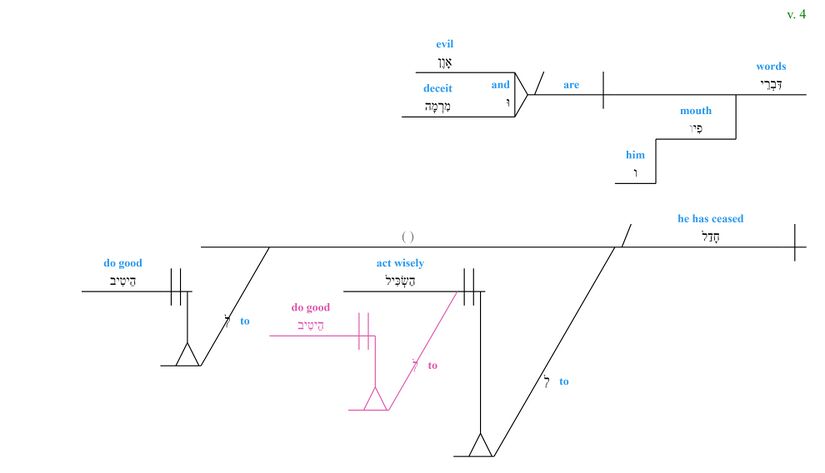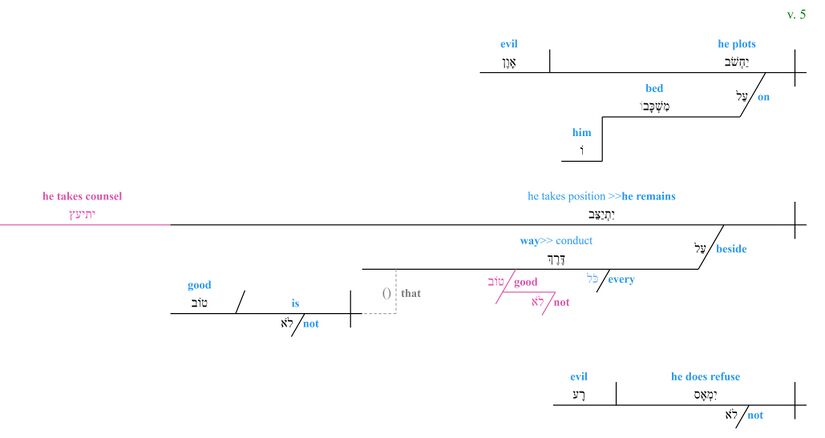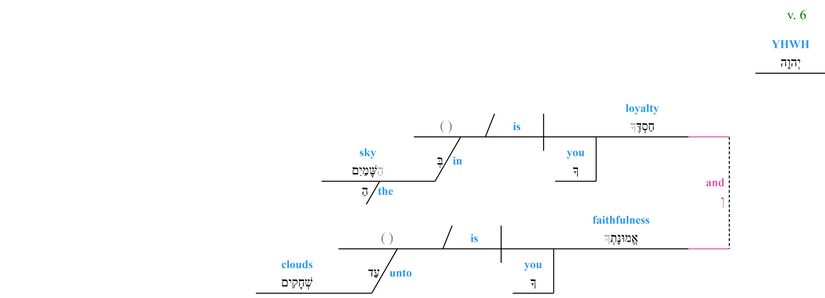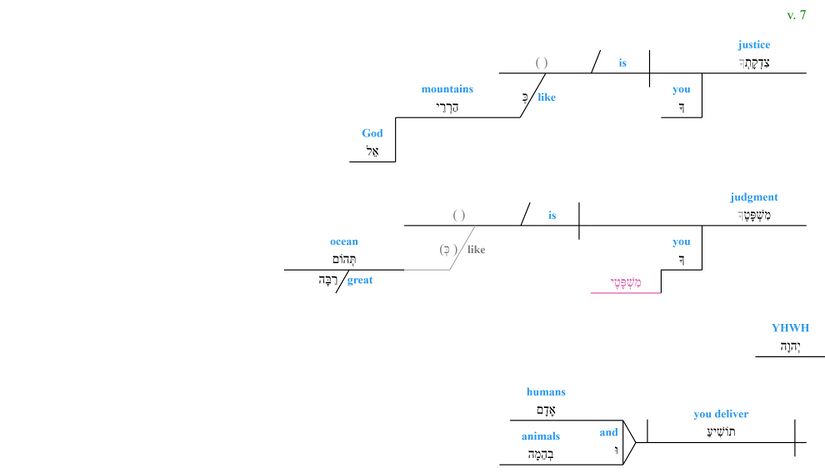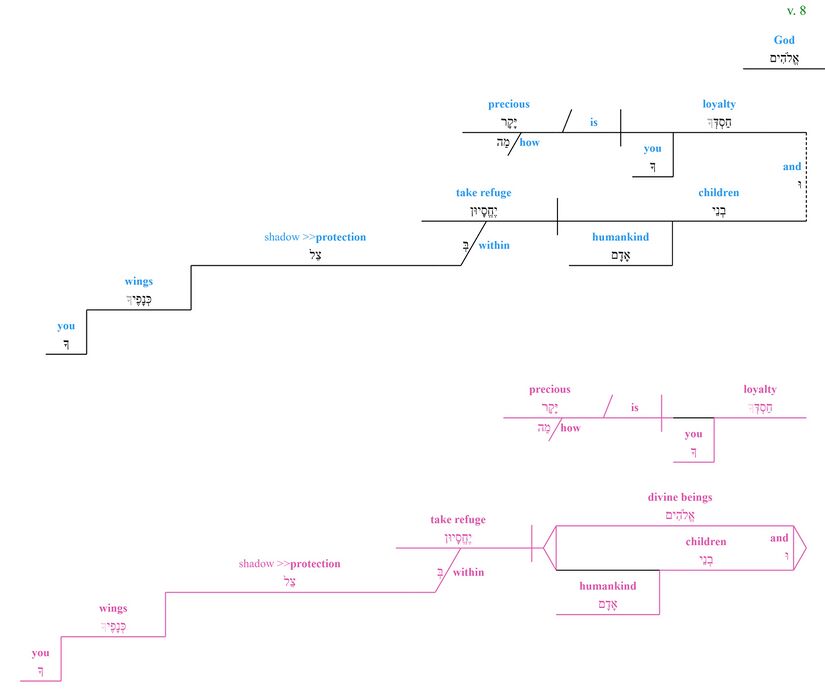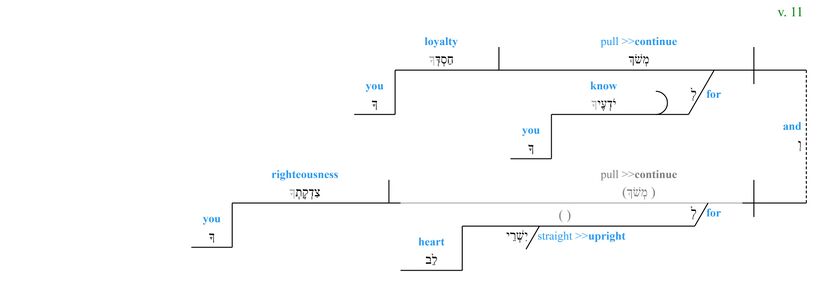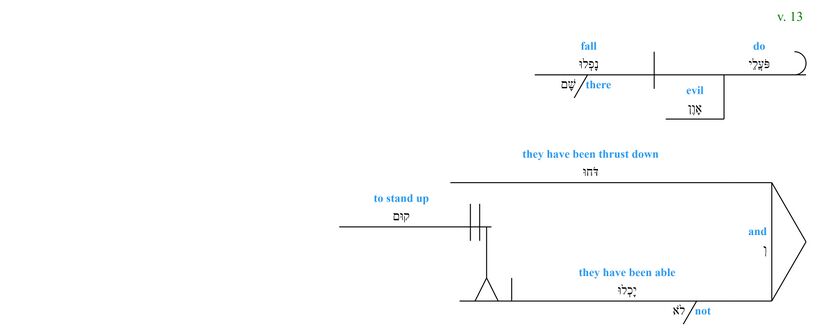Psalm 36 Grammar
About the Grammar Layer
The grammar layer visually represents the grammar and syntax of each clause. It also displays alternative interpretations of the grammar. (For more information, click "Expand" to the right.)
The grammatical diagram provides a way to visualise how different parts of a sentence work together. It represents the “surface-level” grammar, or morphosyntax, of a sentence. Morphosyntax includes both the form of words (morphology) and their placement in the sentence (syntax). This approach to visualising the text, based on the Reed-Kellogg diagramming method, places the grammatical subject in one slot, the verb in another slot, and modifiers and connectives in other slots.
For a detailed description of our method, see the Grammar Creator Guidelines.
Grammar Visuals for Psalm 36
The grammar layer visually represents the grammar and syntax of each clause. It also displays alternative interpretations of the grammar. (For more information, click "Grammar Legend" below.)
| Visualization | Description |
|---|---|
| The clause is represented by a horizontal line with a vertical line crossing through it, separating the subject and the verb. | |
| The object is indicated by a vertical line that does not cross the horizontal line of the clause. Infinitives and participles may also have objects. If the direct object marker (d.o.m.) is present in the text, it appears in the diagram immediately before the object. If the grammar includes a secondary object, the secondary object will appear after the object, separated by another vertical line that does not cross the horizontal line of the clause. | |
| The subject complement follows the verb (often omitted in Hebrew) separated with a line leaning toward the right. It can be a noun, a whole prepositional phrase or an adjective. The later two appear modifying the complement slot. | |
| When a noun further describes or renames the object, it is an object complement. The object complement follows the object separated by a line leaning toward the right. | |
| In a construct chain, the noun in the absolute form modifies the noun in the construct form. | |
| Participles are indicated in whatever position in the clause they are in with a curved line before the participle. Participles can occur as nominal, where they take the place of a noun, predicate, where they take the place of a verb, or attributive, where they modify a noun or a verb similar to adjectives or adverbs. | |
| Infinitives are indicated by two parallel lines before the infinitive that cross the horizontal line. Infinitive constructs can appear as the verb in an embedded clause. Infinitive absolutes typically appear as an adverbial. | |
| The subject of the infinitive often appears in construct to it. In this situation, the infinitive and subject are diagrammed as a construct chain. | |
| The object of the infinitive is indicated by a vertical line that does not cross the horizontal line of the infinitival clause. | |
| Modifiers are represented by a solid diagonal line from the word they modify. They can attach to verbs, adjectives, or nouns. If modifying a verb or adjective, it is an adverb, but if modifying a noun, it is an adjective, a quantifier, or a definite article. If an adverb is modifying a modifier, it is connected to the modifier by a small dashed horizontal line. | |
| Adverbials are indicated by a dashed diagonal line extending to a horizontal line. These are nouns or infinitives that function adverbially (modifying either a verb or a participle), but are not connected by a preposition. | |
| Prepositional phrases are indicated by a solid diagonal line extending to a horizontal line. The preposition is to the left of the diagonal line and the dependent of the preposition is on the horizontal line. They can modify verbs (adverbial) or nouns (adjectival). | |
| Embedded clauses are indicated by a "stand" that looks like an upside-down Y. The stand rests in the grammatical position that the clause fulfills. Extending from the top of the stand is a horizontal line for the clause. If introduced by a complementizer, for example כִּי, the complementizer appears before the stand. Embedded clauses can stand in the place of any noun. | |
| When clauses are joined by a conjunction, they are compound clauses. These clauses are connected by a vertical dotted line. The conjunction is placed next to the dotted line. | |
| Within a clause, if two or more parts of speech are compound, these are represented by angled lines reaching to the two compound elements connected by a solid vertical line. If a conjunction is used, the conjunction appears to the left of the vertical line. Almost all parts of speech can be compound. | |
| Subordinate clauses are indicated by a dashed line coming from the line dividing the subject from the predicate in the independent clause and leading to the horizontal line of the subordinate clause. The subordinating conjunction appears next to the dashed line. | |
| Relative clauses also have a dashed line, but the line connects the antecedent to the horizontal line of the relative clause. The relative particle appears next to the dashed line. | |
| Sentence fragments are represented by a horizontal line with no vertical lines. They are most frequently used in superscriptions to psalms. They are visually similar to discourse particles and vocatives, but most often consist of a noun phrase (that does not refer to a person or people group) or a prepositional phrase. | |
| In the body of the psalm, a horizontal line by itself (with no modifiers or vertical lines) can indicate either a discourse particle or a vocative (if the word is a noun referring to a person or people group). A discourse particle is a conjunction or particle that functions at the discourse level, not at the grammatical level. Vocatives can appear either before or after the clause addressed to them, depending on the word order of the Hebrew. | |
| Apposition is indicated by an equal sign equating the two noun phrases. This can occur with a noun in any function in a sentence. |
| Hebrew text colors | |
|---|---|
| Default preferred text | The default preferred reading is represented by a black line. The text of the MT is represented in bold black text. |
| Dispreferred reading | The dispreferred reading is an alternative interpretation of the grammar, represented by a pink line. The text of the MT is represented in bold pink text, while emendations and revocalizations retain their corresponding colors (see below). |
| Emended text | Emended text, text in which the consonants differ from the consonants of the Masoretic text, is represented by bold blue text, whether that reading is preferred or dispreferred. |
| Revocalized text | Revocalized text, text in which only the vowels differ from the vowels of the Masoretic text, is represented by bold purple text, whether that reading is preferred or dispreferred. |
| (Supplied elided element) | Any element that is elided in the Hebrew text is represented by bold gray text in parentheses. |
| ( ) | The position of a non-supplied elided element is represented by empty black parentheses. For example, this would be used in the place of the noun when an adjective functions substantivally or in the place of the antecedent when a relative clause has an implied antecedent. |
| Gloss text colors | |
|---|---|
| Gloss used in the CBC | The gloss used in the Close-but-Clear translation is represented by bold blue text. |
| Literal gloss >> derived meaning | A gloss that shows the more literal meaning as well as the derived figurative meaning is represented in blue text with arrows pointing towards the more figurative meaning. The gloss used in the CBC will be bolded. |
| Supplied elided element | The gloss for a supplied elided element is represented in bold gray text. |
v. 1
- For the various options for understanding למנצח, see Lamnaṣṣēaḥ.
- The prep. phrase, לְעֶבֶד־יְהוָה, is diagrammed as a separate fragment, similar to the following prep. phrase, לְדָוִד. Most modern translations understand עֶבֶד־יְהוָה and דָוִד as appositional — "Of David, the servant of the Lord" (ESV; cf. NIV, NET, NLT, LUT, HFA, EÜ). The same phrase occurs elsewhere in the superscription of Ps 18:1 - לַמְנַצֵּחַ לְעֶבֶד יְהוָה לְדָוִד "A psalm of David, the servant of the Lord" (ESV).
- For the various options for understanding לדוד, see Ledavid.
vv. 2-3
- When נאם is the first member of a construct phrase, the second member "always denotes the speaker, not the thing spoken" (Delitzsch 1871, 3; cf. Gen 22:16; Num 24:3, 15; Ps 110:1). So here an oracle is spoken by the rebel(lion); it is not an oracle about or concerning the rebel(lion). The following ל prep. introduces the recipient of this speech — the wicked person. A similar construction occurs in Ps 110:1: נְאֻם יְהוָה לַאדֹנִ "The LORD says to my Lord" (ESV) in which YHWH speaks to a Lord. If Ps 36:2 is understood this way, it reads "Rebellion's declaration [is/speaks] to the wicked person." For a fuller treatment of the various options for understanding this phrase, see The Text, Grammar, and Meaning of Ps. 36:2a.
- Which is the correct pronominal suffix for לב: the first-person singular (yod; my heart) or third-person singular (waw; his heart)? Ancient versions and modern translations are divided.
- First-Person: The first-person suffix is attested in the MT (לִבִּי) and TgPs. (לבבי). Several modern translations adopt this reading: "An oracle within my heart concerning the transgression of the wicked person" (CSB; cf. NIV, NKJV, EÜ).
- Third-Person: The third-person suffix is attested in Aquila (αὐτο̣ῦ̣), Quinta (αὐτοῦ· ἑαυτ(ῷ)), Origen's LXX (αυτ(ῷ) ἑαυτῳ), Syr. (ܒܠܒܗ), and indirectly in the LXX (ἑαυτῷ) and Vulg. (ipso). Several modern translations adopt this reading: "Transgression speaks to the wicked deep in his heart" (ESV; cf. NASB, LSB, LUT, ELB, ZÜR).
- Preferred: The graphic similarity between yod and waw (e.g., Ps 59:10 (עזו / עזי); see Delitzsch 1920, 46; Tov 2022, 303), in addition to the divided testimony of the ancient versions, suggests that this issue will not be resolved on external grounds (i.e., by ms evidence) alone. Perhaps more determinative in this case is internal evidence: which reading makes the most/least sense in context? The first-person suffix seems out of place in the context. Though elsewhere the prophetic formula (i.e., נאם followed by proper noun/substantive participle) precedes, interrupts, or concludes direct speech (cf. Gen 22:16; 1 Sam 2:30; Hos 2:15) — speech which is typically first-person — it does not do so here; "rebellion" does not speak in first-person, nor does the psalmist. The third-person suffix, on the other hand, fits within the context. The remainder of the opening section (vv. 2-5) contains only third-person language/suffixes. The psalmist is thus narrating/describing the wicked person in third-person. That the third-person reading fits better within the context and is strongly attested in certain ancient versions (including Hebrew mss) leads us to emend the MT's first person reading, לִבִּי (my heart) to לִבּוֹ (his heart). We conclude that at some point during the transmission of the Hebrew text, the third-person suffix (waw) was mistakenly read and copied as a first-person suffix (yod) (see The Text, Grammar, and Meaning of Ps. 36:2a).
- The text לִמְצֹא עֲוֺנוֹ לִשְׂנֹא includes two לְ + infinitive construct phrases whose relationship to the previous text, and to one another, is not entirely clear. For a fuller treatment of the various options, see The Syntax and Meaning of Ps. 36:3.
v. 4
v. 5
- The beginning of v. 5b in the MT reads יִתְיַצֵּב עַל־דֶּרֶךְ "he sets himself in a way" (ESV), which consists of a verb (יִתְיַצֵּב) and a prepositional phrase (עַל־דֶּרֶךְ). The sense of the text is clear, however a certain Qumran fragment, 4Q83, preserves a different reading. The beginning of v. 5b in 4Q83 reads יתיעץ כול דרך "he takes counsel [by/regarding] every way". The text of 4Q83 preserves a different verb than MT and lacks MT's על preposition. Adding to the complexity of this issue is the reading of the LXX: παρέστη πάσῃ ὁδῷ "he stands beside every way". The LXX's verb, παρέστη, is likely a translation of MT's verbal root, יצב; however, "every way" agrees with 4Q83's כול דרך "every way" over against MT. If the correct reading(s) is/are contained in a single text, which text (MT, 4Q83, LXX) contains the correct reading?
- MT: The verb יצב is attested only in the hithpael stem and is commonly followed by a prep. indicating location (DCH; e.g., ב, על, לפני). In Num 22:22, the messenger of YHWH "took his stand in the way" (ESV; וַיִּתְיַצֵּב...בַּדֶּרֶך). The prep. phrase, על דרך (on/beside a way (sg. or pl.)), is not uncommon (cf. Gen 38:14; Judg 5:10; 1 Sam 24:4; 1 Kgs 20:38; Isa 49:9; Jer 3:2) and MT's reading, יִתְיַצֵּב עַל־דֶּרֶךְ, aligns well with similar expressions elsewhere; there is thus no semantic issue with the phrase "he sets himself on a way."
- LXX: The LXX's reading seems to contain elements from both MT and 4Q83's readings. It may reflect both על (MT) and כל (4Q83), perhaps translating a source which read יתיצב על כל דרך "he stands upon/beside every way". Elsewhere the LXX translates a phrase similar to v. 5b — הַנִּצָּבִים עָלָיו (Gen 45:1) — as παρεστηκότων αὐτῷ; the LXX translates the prep. phrase (עָלָיו) with a dative (αὐτῷ) and not an independent preposition (ἐπί; cf. Gen 1:11; Ps 2:6). Therefore, it is possible that the LXX's reading here, παρέστη πάσῃ ὁδῷ, in which πάσῃ ὁδῷ is in the dative, does represent MT's על; as Gen 45:1 demonstrates, על can be rendered by a dative in Greek when it follows the verb παρίστημι.
- 4Q83: The most unique feature of 4Q83's reading is the different verb it preserves — יתיעץ "he takes counsel" — when compared to MT and LXX. In addition, 4Q83 does not include the על prep. present in MT (and possibly also LXX). Thus 4Q83 includes a verb and an adverbial accusative, which can be rendered as "he takes counsel [by/regarding] every way."
- Preferred: Perhaps the LXX contains the earliest recoverable reading — "he stands beside every way" (παρέστη πάσῃ ὁδῷ). This suggests an underlying Hebrew text which read יתיצב על כל דרך. This reading can best explain the others. After finishing writing על, a scribe's eye could have easily skipped to the lamed of כל, omitting it altogether and resulting in MT's reading (יִתְיַצֵּב עַל־דֶּרֶךְ). Perhaps 4Q83's unique verb יתיעץ, being a closer semantic parallel to יַחְשֹׁב (plot), represents a scribe's attempt to unify the depiction of the wicked person via three descriptions of his mind — the wicked person "plots, takes counsel, and rejects." It is easier to see how יתיצב could have been changed to יתיעץ to align more closely with the context, but it is it difficult to see the reverse. We therefore conclude that the earliest recoverable text reads יתיצב על כל דרך "he stands beside every way."
- It is possible to understand לֹא־טוֹב (not good) as an unmarked relative clause modifying דֶּרֶךְ (way): "He sets himself in a way that is not good" (ESV; cf. NASB, CSB, NKJV, NGÜ, ELB). Two ancient versions understand לֹא־טוֹב as an unmarked relative clause, providing a relative marker: Syr. (ܐܝܕܐ) and TgPs. (ד). Other examples of unmarked relative clauses include: Ex 18:20; Deut 32:17; Ps 7:16 (see Holmstedt 2016, 81-83).
v. 6
- Certain ancient versions include a conjunction before their translation of אֱמוּנָתְךָ, perhaps reading וֶאֱמוּנָתְךָ in their source: LXX - καὶ ἡ ἀλήθειά "and your truth" (NETS); Syr. - ܘܗܝܡܢܘܬܟ "and your faithfulness." Some Hebrew MSS also read a waw conjunction before אֱמוּנָתְךָ (see Kennicott 1776, 335). Though perhaps not the most exegetically significant variant, the presence or absence of the waw conjunction can affect how one understands the relationship between the clauses of v. 6; are they coordinated explicitly (waw) or implicitly (no waw)?
v. 7
- Should מִשְׁפָּטֶךָ (your decree) be read with MT as a singular or with other ancient versions (LXX, Syr.) as a plural?
- Singular: The MT reads מִשְׁפָּטֶךָ תְּהוֹם רַבָּה (your decree [sg.] is like the great deep). Several modern translations follow MT, reading a singular: "your justice like the great deep" (NIV; cf. NET, GNB, NLT, LUT, ELB).
- Plural: The LXX reads τὰ κρίματά σου ἄβυσσος πολλή "your judgments [pl.] are a great deep" (NETS) and Syr. reads ܘܕܝܢ̈ܝܟ ܐܝܟ ܬܗܘܡܐ ܪܒܐ "your judgments [pl.] are like the great deep" (see Taylor 2020, 133 fn. 5). In this case the plural readings of LXX and Syr. may reflect a Hebrew source which read משׁפטיך (your judgments). The plural reading is also reflected in many Cairo Genizah manuscripts. Several modern translations adopt the plural reading: "your judgments are like the great deep" (ESV; cf. HFA, NGÜ, EÜ, GNB, ZÜR).
- Preferred: It is difficult to determine the original reading with certainty. Both the singular (your decree) and plural (your judgments) make sense in context and are viable options. Regarding the potential for scribal error, it seems equally as likely that a scribe would have omitted the yod as he would have added it. The data does not favor a particular reading, in which case it is best to retain MT — the singular מִשְׁפָּטֶךָ (your decree).
- Though not present in the MT, the editors of BHS suggest that a כְּ preposition should be read before תְּהוֹם רַבָּה (e.g., like the great deep). They posit that the כְּ prep. was omitted due to haplography — "the erroneous omission of one or more adjacent letters" (Tov 2022, 300; e.g., an eye-skip from כ to ת). A similar prep. is attested in the Syr. (ܐܝܟ) and TgPs. (היך) and is supplied by several modern translations (ESV - like; cf. NET, NIV, CEV, GNB, NLT). That a scribe omitted כְּ due to haplography is certainly possible, however this mistake must have happened quite early during transmission, for the prep. is not reflected by the LXX (τὰ κρίματά σου ἄβυσσος πολλή) nor is it present in any known Hebrew manuscripts (see Kennicott 1776, 335). Perhaps, then, those versions that include the prep. (Syr. and TgPs.) represent an attempt to explicate the implicit sense of the phrase, maintaining the perceived parallelism between the A and B lines of v. 7: E.g., If YHWH's righteousness is like the mountains of God, so his justice is like the great deep. In this case, the prep. of the A line (כְּ) is elided — and therefore implied — in the B line (cf. Ps 58:9; see Dahood 1966, 435-437). This could also be the case in v. 9 where the מִן prep. of the A line (יִרְוְיֻן מִדֶּשֶׁן בֵּיתֶךָ) is elided in the B line (וְנַחַל עֲדָנֶיךָ תַשְׁקֵם).
- Preferred: The lack of manuscript support suggests that the כְּ prep. is not original. It is present in some ancient versions (Syr., TgPs.) and several modern translations (ESV, NET, NIV) in order to explicate the implicit sense of the phrase — that YHWH's justice is like the great deep. The absence of the כְּ prep. in the Hebrew text is due to a feature of BH poetry to elide prepositions in the B line.
v. 8
- Coupled with the adjective יָּקָר (precious), מַה has an adverbial meaning (i.e., how!, how?, why?; JM §144e). It signals the "introduction to an exclamation" in which the psalmist "expresses a value judgment" about the value of YHWH's steadfast love — "How precious is your steadfast love[!]" (ESV; so also NET, NIV, GNB, NLT; see BHRG §43.3.2.4; IBHS 18.3f; JM §144e; cf. Num 24:5; Ps 8:2). The LXX understands מה this way also: ὡς ἐπλήθυνας τὸ ἔλεός σου "How you increased your mercy" (NETS). Though the phrase is most likely an exclamation (!), it should be kept in mind that "the line between a question and an exclamation is often ill-defined" (JM §162a).
- Because אֱלֹהִים is located at the border of two clauses, it can be read one of two ways: as a vocative grouped with the preceding clause — "How precious is your steadfast love, O God! (ESV) — or as a subject grouped with the succeeding clause — "Gods and frail mortals seek refuge in the shadow of your wings (REB).
- Vocative (preferred): In favor of reading אֱלֹהִים as a vocative grouped with the preceding clause is the strong disjunctive accent — 'ole weyored — placed on אֱלֹ֫הִ֥ים, which indicates a main verse division (Yeivin 1985, 265); the lineation in Rahlf's LXX in which "God" appears at the end of its line (ὡς ἐπλήθυνας τὸ ἔλεός σου, ὁ θεός) and is grouped with the preceding clause as a vocative (the following line in Rahlf's begins with οἱ δὲ υἱοὶ τῶν ἀνθρώπων, in which only "the sons of men" functions as the subject of its clause). In addition, the Syr. and TgPs. also understand אֱלֹהִים as a vocative: Syr. - ܡܐ ܣ̈ܓܝܐܝܢ ܪ̈ܚܡܝܟ ܐܠܗܐ "How many are your mercies, O God!" (Taylor); TgPs. - כמה יקר טובך יהוה 'How precious is your goodness, O LORD!" (Stec). The Vulg. also understands אֱלֹהִים as a vocative: quam pretiosa est misericordia tua Domine. Most modern translations read a vocative: "How precious is your steadfast love, O God!" (ESV; cf. NET, NIV, GNB, NLT). Elsewhere, In Num 24:5, a מה exclamatory is followed by a vocative: מַה־טֹּבוּ אֹהָלֶיךָ יַעֲקֹב "How lovely are your tents, O Jacob" (ESV; cf. Ps 8:2, where a מה exclamatory is preceded by a vocative).
- Subject: A couple of modern translations read אֱלֹהִים as a subject grouped with the succeeding clause: "Gods and frail mortals seek refuge in the shadow of your wings" (REB); "Götter und Menschen suchen Zuflucht im Schatten deiner Flügel" (ZÜR). There is no grammatical issue with this option, for אֱלֹהִים and בְנֵי אָדָם function as the compound subject of a plural verb, יֶחֱסָיוּן. In favor of this view is the similar word count among the poetic lines of v. 8: מַה־יָּקָר חַסְדְּךָ (two prosodic words); אֱלֹהִים וּבְנֵי אָדָם (three prosodic words); בְּצֵל כְּנָפֶיךָ יֶחֱסָיוּן (three prosodic words). This is in keeping with the line length of the surrounding verses: v. 7: 2-3-3; v. 8: 2-3-3; v. 9: 3-3. If אֱלֹהִים is read as a vocative, the poetic lineation results in an unbalanced prosodic word count in v. 8: 3-5.
vv. 9-10
- The כי conjunction in v. 10 "marks a clause that provides a reason" (BHRG §40.9.2.2). In this case it signals the "motivation given by speakers [the psalmist] to explain something they have said" (BHRG §40.9.2.2.2). Because the "spring of life" is with God (v. 10), mankind can be "sated by the fatness" from his house and given drink from the wadi of his delights (v. 9). This understanding of כי is reflected in the ancient versions (LXX - ὅτι; Syr. - ܡܛܘܠ; Vulg. - quoniam) and is adopted by many modern translations (ESV - for; cf. NET, NIV, NLT, LUT, HFA, ELB, EÜ, ZÜR).
v. 11
v. 12
- Both of the verbs in v. 12 (תְּבוֹאֵנִי and תְּנִדֵנִי) feature a 1cs suffix (נִי). Suffixes attached to finite verbs typically have an accusative function. Such is the case with תְּנִדֵנִי "drive me away." However, some verbs with suffixes "[have] the value of a dative and therefore [are] normally capable of being rewritten by means of a preposition other than את" (JM §125ba). Such is the case with תְּבוֹאֵנִי: "come against me."
v. 13
- Commentators have noted that שָׁם (there) seems "remarkable in the context" (Kraus 1988, 397). As an alternative, they suggest that שָׁם be read as a verb — שָׁמְמוּ (they are destroyed) — in order to maintain (or establish) parallelism with the following verb, נָפְלוּ (they fall) (Kraus 1988, 397). Yet other commentators do not see שָׁם as an oddity; they see it is a reference to the temple (cf. Ps 69:36) and perfectly at home in the context of a plea for judgment (cf. Pss 14:4-5; 53:5-6) (NICOT 2014). Perhaps it could also be a reference to the last specified locale of the wicked person — "every way that is not good" (v. 5). The psalmist expresses confidence that those who stand on wicked paths will perish there (cf. Botha 2004, 516n30). The ancient versions agree with MT and support reading שָׁם: LXX - ἐκεῖ (there); Syr. - ܕܬܡܢ (there); TgPs. - תמן (there); Vulg. - ibi (there). The testimony of the ancient versions, in addition to the occurrence of שָׁם in similar contexts elsewhere in the Psalter, suggests that it is best to retain MT's שָׁם (ESV - There [at the temple] the evildoers lie fallen). Because an obvious locational referent is lacking in the context, another option is to understand שָׁם as a mirative particle (e.g., "look!, behold!"; DCH; see Macrosyntax note).
Bibliography
- Botha, P.J. 2004. “The Textual Strategy and Ideology of Psalm 36.” Old Testament Essays 17 (4): 506–20.
- Dahood, Mitchell edt trl. 1966. Psalms. Garden City, N.Y., Doubleday.
- DeClaissé-Walford, Nancy L., Rolf A. Jacobson, and Beth LaNeel Tanner. 2014. The Book of Psalms. NICOT. Grand Rapids: William B. Eerdmans Publishing Company.
- Delitzsch, Franz. 1871. Biblical Commentary on the Psalms: Vol. 2. Translated by Francis Bolton. Vol. 2. T & T Clark.
- Holmstedt, Robert D. 2016 The Relative Clause in Biblical Hebrew. Winona Lake: Eisenbraums.
- Jenni, Ernst. 2000. Die Hebräischen Präpositionen Band 3: Die Präposition Lamed. Stuttgart: Verlag W. Kohlhammer.
- Kraus, Hans-Joachim. 1988. Psalms 1-59: A Commentary. Minneapolis: Augsburg Pub. House.






















